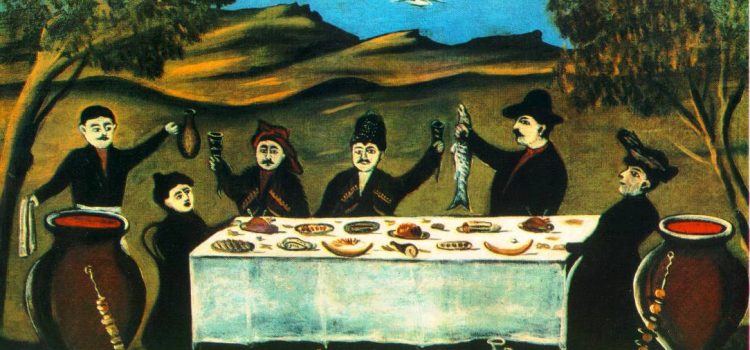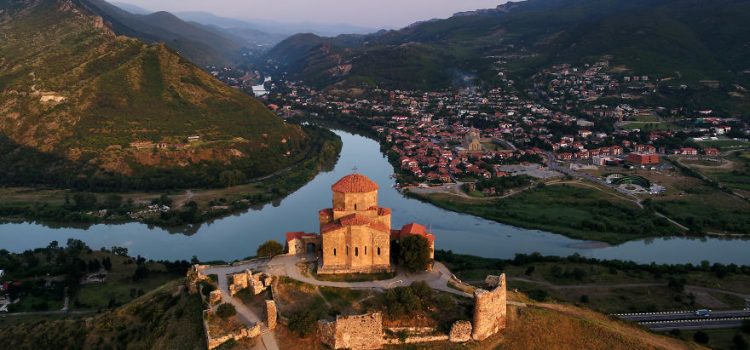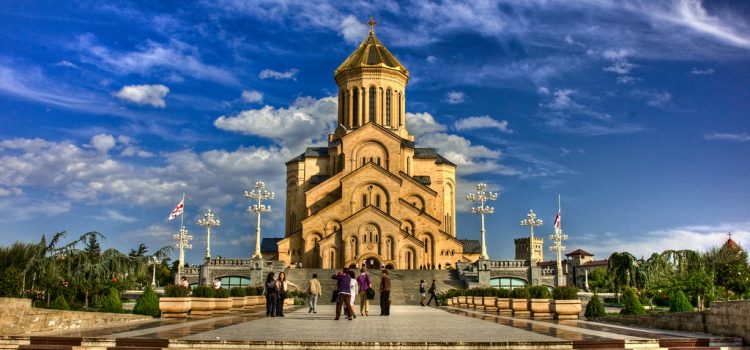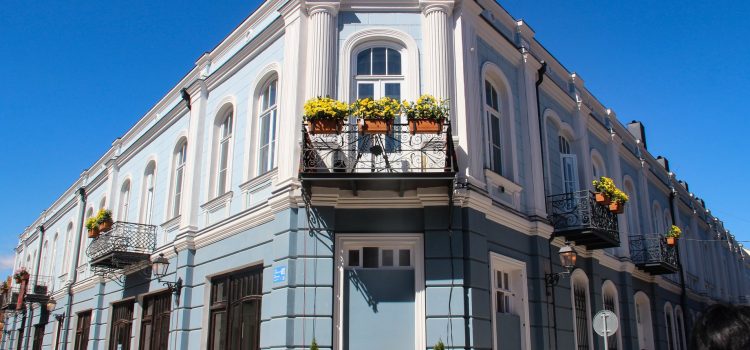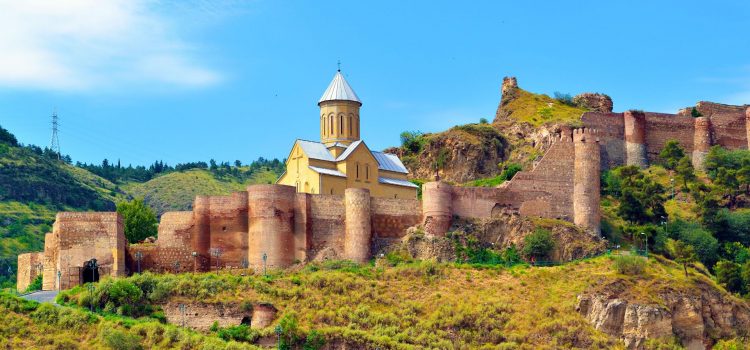Forbes Features “Unique” Georgian Wines
Forbes published an article this week by contributor Lana Bortolot titled ”Why Georgian wines are Among the Most Unique on the Planet”.
Bortolot is a wine, food, and travel reporter who holds the Advanced Wine & Spirits Education Trust certificate and has covered wine regions in more than 16 countries.
In the article, Bortolot explores Georgian wine culture, the role of wine in modern Georgian society, and the technical side of Georgian wine. The piece is peppered with quotes from Georgian wine lovers:
“Even where we think a culture like France or Italy is so wine-centric, Georgians just take it to a whole different level—much deeper than what we’re exposed,” – Taylor Parsons
“There’s something very particular about how Georgians love wine,” he said. “It’s a little eccentric but then you start looking into it and once you do, you’re truly amazed—it’s such an integral part of the culture and everyday life.” – Noel Brockett
“One of the most important things about Georgian wines is that it’s a window into a culture that most of us as Westerners simply don’t have,” – Simon J. Woolf
Bortolot goes on to focus on orange or amber wines, a style growing in popularity worldwide that has long been part of Georgia’s tradition. She also recounts a legend, which said that, in ancient times, “soldiers wove a piece of grapevine into the chain mail protecting their chests, so when they died in battle, a vine sprouted not just from their bodies, but their hearts.”
The article introduces readers to several Georgian wine makers – locals and expats, high end factories and garage operations – celebrating the varied, inclusive culture of Georgian wine.
The article ends with a wine sampler. Bortolot recommends Kisi, Mtsvane, Rkatsiteli, Saperavi, and Tsinandali for beginners.
By Samantha Guthrie, Source: Georgiatoday.ge
Arles Museum to Host the Exhibition of Niko Pirosmani Paintings
After famous Albertina Museum in Vienna, ‘Niko Pirosmani – A Wanderer between Worlds’ will continue its journey through other European countries.
The next ‘stop’ for the exhibition will be Arles Museum of Modern Art in the South of France. The works of the self-taught primitivist painter, who represents a unique figure of Georgian art will be displayed alongside the paintings of the prominent Dutch impressionist Vincent van Gogh, who lived in Arles for a time.
The exhibition is scheduled for March 2019 and will likely last until summer. It was stated by the Georgian National Museum that negotiations are ongoing about the details of the organization of the exposition. The exhibition is prepared by the Georgian National Museum (GNM) network and the Vincent van Gogh Foundation in Arles.
29 works of Pirsomani, currently being displayed at the Albertina Museum, will be showcased in Arles.
The opportunity to exhibit Pirosmani’s paintings at Albertina is considered an unprecedented success in promoting the country and its culture. General Director of the Georgian National Museum David Lordkipanidze told Imedi TV, the given exhibition had record-breaking viewer numbers.
After Austria, the French audience will also be presented a chance to observe the paintings of Pirosmani and explore the Georgian avant-garde.
By Ketevan Kvaratskheliya, Source: Georgiatoday.ge
Image source: imedinews.ge
Georgian Food Named as Cuisine of the Year by Af&co
Af&Co has named Georgian food as Cuisine of the Year and Khachapuri as its dish of the year in its 2019 Trends Report.
Based in San Francisco, af&co is a leading restaurant and hospitality consulting firm. Their report identifies the hottest key trends in restaurants, food and beverage, and hospitality marketing.
The Ajarian dish Khachapuri has been awarded the title of Dish of the Year thanks to its tasty combination of cheese and egg, and its instagramability. It’s already being served in some restaurants in the US, including Supra in Washington DC, Cheeseboat in Brooklyn and Barbounia in New York.
The Trends Report was the eleventh edition published by af&co. Founder Andrew Freeman noted that “the hospitality industry is leading the charge in creating the world we want to live in. Restaurants and hotels are gathering places for people to connect, creating the perfect grounds for people to come together, get personal, and embrace forward-thinking ideas.”
By Amy Jones, Source: Georgiatoday.ge
Photo source: reddit.com
Bakuriani – Skiing resort in Georgia
Bakuriani is known for days with long sunshine, for 2052 hours a year and long snowy winter from December to March. Winters are cold and experience sufficient snowfall while summers are long. Average January temperature is – 7 and in August +15 degrees by Celsius. Average snow cover makes 64 cm.
Cristal clean air of high mountains, predominantly coniferous (mainly made up of spruce) forest filled with the perfume of beech trees, Kokhtagora, Kokhtagora II and views of mountains of Tskhratskaro attract attention of visitors during all seasons of the year.
No wonder that Bakuriani is one of the most famous mountain resorts among Georgian international ski resorts. Its climate and relief is ideal for the development of varieties of winter sports. First skiers were fixed here in 1932.
During winter seasons families with kids and fans of skiing adults equally enjoy staying here. Cable ways can be found in several places, on the Kokhtagora mount (1.3 km), Kokhtagora II, Sakhvelo mount (3.8km), under 90 and 25 m. ski jumps and there are also places for tobogganing in the park. The Kokhtagora along with other ski runs is one of the best difficult skiing runs for professional skiers.
Bakuriani is a mountain-climate resort with its main curative factors: mountain air, long time sunshine, high activity of ultraviolet rays. One can be cured here from lymphadenitis, chronic non-tuberculosis illnesses of respiratory tract and anemia. One can visit High-Mountain Botanical Gardens, the branch of the Tbilisi Botanical Institute (founded in 1919) with the best collection of alpine flora in Europe.
5 Things Not to Miss:
1. Snowmobile sightseeing
2. Sledges and horse riding
3. Parks for kids
4. Panoramic views
5. Après ski
Source: Skigeorgia.ge
Jvari monastery in old capital – Mtskheta
According to local history, in the early fourth century a wooden cross was erected over a pagan sanctuary on a rocky mountaintop overlooking Mtskehta, the former capital of the Georgian Kingdom of Kartli-Iberia. The construction of the cross symbolized the fall of paganism and rise of Christianity in Georgia. In 545, a cruciform church, known as the Small Church of Jvari, was built just north of the cross. Between 586 and 605, a larger church was constructed directly above the site of the wooden cross, the base of which is still visible inside the church. Exceptional relief sculptures decorate the exterior façades of the Great Church. Their fine proportions and remarkable technique distinguished the sculptures from the earlier bas-relief carving common in the region. In 2004, the monastery was placed on the UNESCO World Heritage List as part of the Historical Monuments of Mtskheta and was added to the UNESCO List of World Heritage in Danger in 2009.
2006 World Monuments Watch
Greatly deteriorated from centuries of water damage, violent regional conflicts, and inadequate maintenance, Jvari Monastery was included on the 2006 World Monuments Watch. Missing its roof, the interior mosaics and frescoes of the small church have been largely destroyed by the elements. Heavy pressure from the upper walls and dome threaten the Great Church’s structural stability, while acid rain and strong winds had eroded the exterior bas-reliefs. In the late 1980s, restoration works on the small church were halted for fear of endangering the authenticity
of the church. Later restorations in 2002 were suspended for the same reason, having lost most of the original building records in a fire in 1991. In 2006, WMF supported the thorough documentation of the buildings and a study of the original construction and consequent interventions. The project allowed for the development of conservation guidelines for the monastery. A joint stone conservation and training project by Ministry of Culture and ICCROM established in 2005 worked on the conservation of the Great Church’s bas-reliefs, completed in October 2011. A proposal for the conservation of the small church and for the rehabilitation of visitor infrastructure was then submitted to the World Heritage Center.
Located at the precipice of a vertical cliff, Jvari Monastery is a remarkable sacred landmark visible from the ancient city Mtskheta. The building techniques and high standards of engineering, as well as the diverse decorative program, of the landscaped monastery exemplify exceptional centuries-old Georgian building practices alongside a wide range of Eastern and Western aesthetic traditions. Although the tetraconch architectural type did not originate in Georgia, it underwent a unique and complex development in the country. The Great Church represents the peak of this architectural typology and serves as a model for numerous other churches. Jvari has been an important pilgrimage site since its founding and is considered one of the most sacred places in all of Caucasus. The Great Church is still used today for major celebrations.
Source: www.wmf.org
Georgia – ideal climate conditions for Icewine
Georgia is widely considered as a cradle of wine. It is the country where the earliest evidence of grape wine-making was found. Telltale chemical signs of wine in the pottery jars, discovered in two Neolithic villages (called Gadachrili Gora and Shulaveris Gora about 50km (30 miles) south of Tbilisi, the capital of Georgia) dates back 5,980 BC. Previously, the earliest evidence of grape wine-making had been found in the Zagros Mountains of Iran and dated to 5,400-5,000 BC.
Icewine is believed to originate from Germany in the 1700s when freezing weather preceded the harvest and still, winemakers pressed the frozen grapes fermenting the juice to a sweet wine. The winemakers were impressed with the result and they decided to continue with the technique. The type of wine gradually evolved into a classical winter wine and spread throughout the world.
Georgia is one of those countries producing and exporting Icewine. The idea of producing Icewine in Georgia was initiated by one of the German consultants working at Marani, the only producer company of the wine in Georgia. Observing climate conditions in Georgia, the consultant was certain that the production would succeed.
Georgia is characterized by warm summers and cold winters that are ideal conditions for Icewine. Grapes are ripened in summer and frozen in winter. In order to make Icewine, Georgian winemakers do not harvest grapes until freezing weather sets in. Then, grapes are left to freeze naturally on the vine. After the water contained in grapes are frozen, the crops are harvested and pressed. What is produced from the frozen grapes is a small amount of sweet juice without any water.
As the amount of juice squeezed out of the frozen grapes is not impressive and a special pressing technology is required, the production of the wine is not massive and the price is quite high. Besides, it is focused on a limited number of consumers who love sweet wine.
Source: Georgianjournal.ge
Holy Trinity Cathedral of Tbilisi
The Holy Trinity Cathedral of Tbilisi commonly known as Sameba is the main cathedral of the Georgian orthodox church, located in Tbilisi, the capital of Georgia. Constructed between 1995 and 2004, it is the third tallest Eastern Orthodox cathedral in the world and one of the largest religious building in the world by total area. Sameba is a synthesis of traditional styles dominating the Georgian church architecture at various stages in history and has some Byzantine undertones.
The idea to build a new cathedral to commemorate 1,500 years of autocephaly of the Georgian Orthodox Church and 2,000 years from the birth of Jesus merged as early as 1989, a crucial year for the national awakening of the then Soviet republic of Georgia. In May 1989, the Georgian Orthodox Patriarchate and the authorities of Tbilisi announced an international contest for the “Holy Trinity Cathedral” project. No winner was chosen at the first round of the contest when more than a hundred projects were submitted. Finally the design by architect Archil Mindiashvili won. The subsequent turbulent years of civil unrest in Georgia deferred this grandiose plan for six years, and it was not until November 23, 1995, that the foundation of the new cathedral was laid.
The construction of the church was proclaimed as a “symbol of the Georgian national and spiritual revival” and was sponsored mostly by anonymous donations from several businessmen and common citizens. On November 23, 2004, on St. George’s Day, the cathedral was consecrated by Catholicos Patriarch of Georgia Ilia || and high-ranking representatives of fellow Orthodox Churches of the world. The ceremony was also attended by leaders of other religious and confessional communities in Georgia as well as by political leaders.
The Sameba Cathedral is erected on the Elia Hill, which rises above the left bank of the Mtkvari river in the historic neighborhood of Avlabari in Old Tbilisi.
Source: Wikipedia.com
Georgia must see place: David Aghmashenebeli Avenue
There are many must see places in Tbilisi, but now we want to speak about David Agmashenebeli Avenue
It’s one of the main avenues in the historical part of Tbilisi, known for its 19th-century classical architecture. The avenue is located on the left bank of the Mtkvari river, and runs from Saarcbruken, Square to Giorgi Tsabadze street. Currently named after David |V of Georgia, it was originally called Mikheil Street in 1851, and Plekhanov Street after the Russian revolutionary George Plekhanov, from 1918 to 1988.
Since 2010, the avenue has seen major rehabilitation works, which includes the renovation of seventy buildings, as well as the road, sidewalks and street lighting.
Agmashenebeli is easily accessible by metro at Marjanishvili metro, which is a single stop away from the city’s second historical artery – Rustaveli avenue.
Source: Georgia.travel
Photo: Tbilisi development fund
Narikala Fortess in old Tbilisi
Narikala fortess- also called the Mother Fortress of Tbilisi, Narikala is an ancient symbol of Tbilisi’s defence. The fortress was established in the 4th century, around the period when the city itself was founded. It was then known as Shuris-tsikhe (Invidious Fort). The name Narikala is said to derive from a Persian word for citadel, but another theory says was the name that Mongols used, meaning “little fortress”. It was expanded considerably by the Arabs during the 7th and 8th centuries. The Arabs built the Emir’s palace within its walls. King David further extended the Builder the fortress in th 11th century. Most of the existing fortifications date from the 16th and 17th centuries. In 1827 it was damaged by an earthquake and was not resorted. St. Nikolos church, inside the fortress walls, dates from the 12th century. It was renovated in 1996. Narikala offers you some of the best panoramas of the city.
We’d also advise you to take a walk along the Narikala Tourist route, a 1500 metre trail that runs from the top of the ridge near the Mother Georgia statue, around the fortress and down into Old Town to near the entrance to the Botanical Gardens. It offers stunning views at every turn and is a particular delight at night when the city lights shine below.
source: www.inyourpocket.com
Taste Of Georgia: Ajara, Samegrelo, Svaneti
Going to Georgia, travelers usually prepare themselves to enjoy khachapuri, lobio, khinkali and, of course, a variety of meat barbecues, which are called “mtsvadi” in Georgian. Advanced experts in Georgian cuisine leave some free space in the stomach for pkhali, eggplants in walnut sauce, chakhokhbili and kharcho. However, our compact country has such a rich variety of regional dishes, that even if you decide to try one new for breakfast, lunch and dinner, you will need more than several weeks to explore the whole treasury.
Let’s take a little journey through the regions of Georgia and see what they can offer!
Starting with the West Coast… Well, Ajarian cuisine can really be described as “cheese rolling in butter”. Locals prepare very tasty and high-calorie meals. One of them is sinori, gentle rolls made of thin dough baked with matsoni/yoghurt and butter. Sinori can be eaten for breakfast – especially if you days is promising to be busy – or for a heavy family dinner.
Another calorie bomb from Ajara is called borano. It is made of Adjarian cheese melted in butter. Be prepared: it will be difficult to leave the table after you are finished!
Samegrelo, another Western Black Sea region of Georgia, is famous for the fact that its inhabitants prefer very spicy food. Megrelian adjika sauce is so sharp that Chuck Norris himself would probably cry, having tried it. If we talk about dishes, the most significant for the region are gebzhalia and elarji. Elarji is polenta brewed from corn flour with suluguni cheese inside. This heavy delicious dish should served hot!
Gebzhalia is a starter, delicate rolls with fresh cheese and mint in matsoni/yogurt sauce. It just melts inside your mouth, and is contrasting to those extremely spicy dishes and sauces that are served after.
From Samegrelo it is logical to climb higher into the mountains – to Upper Svaneti. This fabulously beautiful region with harsh living conditions is famous first of all for its special seasoning – Svan salt. Common salt is mixed with local spices in a special wooden mortar, and thus turns into slightly moist flavorful spice that can be used with salads, as well as with meat and fish.
Typical Svanetian pastry is kubdari, a tortilla stuffed with meat. In such difficult living conditions as there, meat filling is an excellent source of calories, and tortilla format is a convenient option for takeaway eating. The shepherds take kubdari as they travel to pastures, and eat them during a long time there.
Another traditional Svan pastry is chishdvari (down the mountains, in the rest of Georgia it is called “chvishtari”). It is made from corn flour, and keeps a piece of suluguni cheese inside. Chishdvari is especially tasty, as it’s taken just from a pan, and you eat it looking at the highest peaks of Georgia – let’s say, Shkhara – and breathe fresh air at an altitude of over 2,000 meters.
The first part of our culinary journey through the regions of Georgia is about to end now. Nevertheless, there is still a lot of interesting stuff for you! Stay tuned with Georgia and Travel!
Source: Georgia.travel


